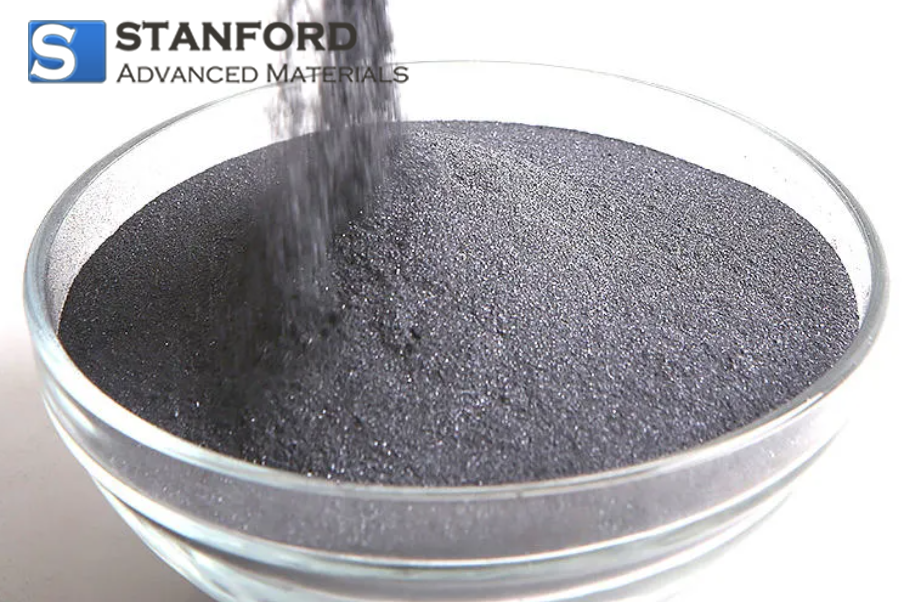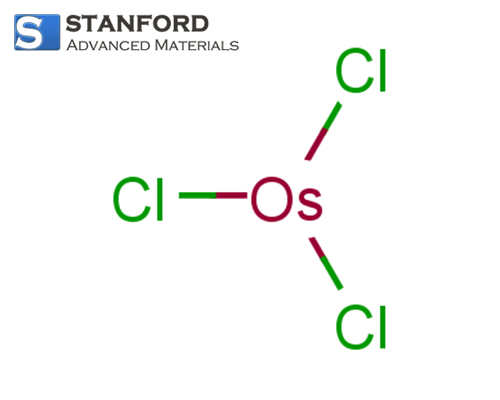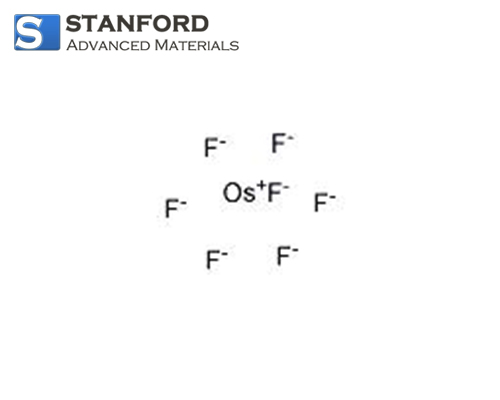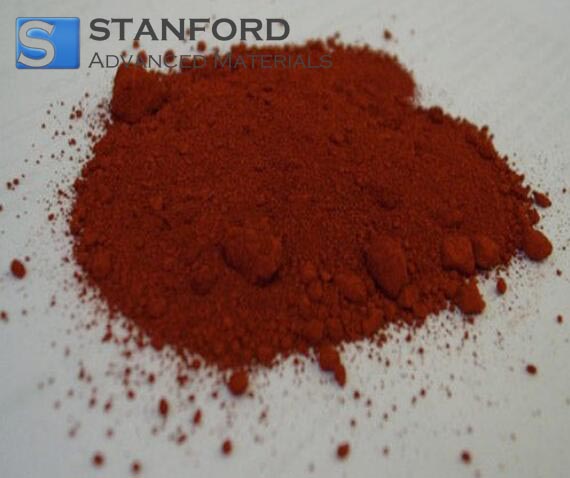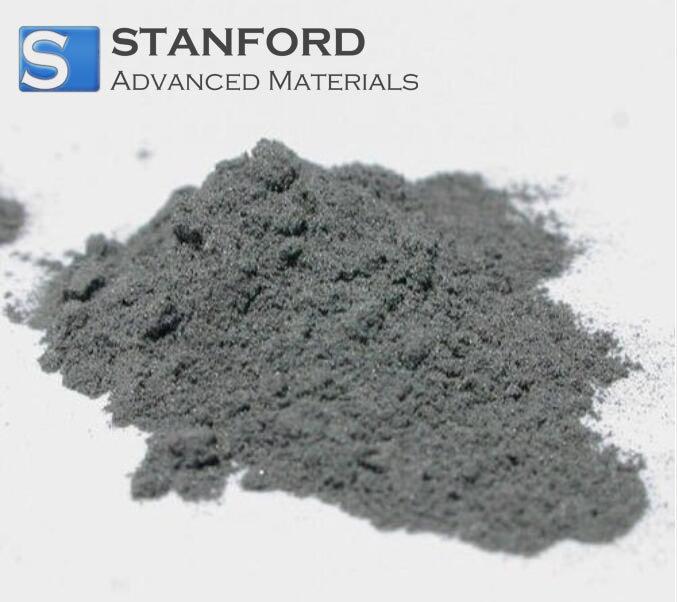SECTION 1. IDENTIFICATION
Product Name: Osmium(III) Chloride
CAS #: 13444-93-4
Relevant identified uses of the substance: Scientific research and development
Supplier details:
Stanford Advanced Materials
E-mail: sales@samaterials.com
Tel: (949) 407-8904
Address: 23661 Birtcher Dr., Lake Forest, CA 92630 U.S.A.
SECTION 2. HAZARDS IDENTIFICATION
2.1 Classification of the substance or mixture
GHS Classification in accordance with 29 CFR 1910 (OSHA HCS)
Acute toxicity, Oral (Category 3), H301
Acute toxicity, Inhalation (Category 3), H331
Acute toxicity, Dermal (Category 3), H311
Skin corrosion (Category 1B), H314
Serious eye damage (Category 1), H318
2.2 GHS Label elements, including precautionary statements
Pictogram
Signal word Danger
Hazard statement(s)
H301 + H311 + H331 Toxic if swallowed, in contact with skin or if inhaled
H314 Causes severe skin burns and eye damage.
Precautionary statement(s)
P260 Do not breathe dust or mist.P264 Wash skin thoroughly after handling.
P270 Do not eat, drink or smoke when using this product.
P271 Use only outdoors or in a well-ventilated area.
P280 Wear protective gloves/ protective clothing/ eye protection/ face
protection.
P301 + P310 IF SWALLOWED: Immediately call a POISON CENTER or doctor/
physician.
P301 + P330 + P331 IF SWALLOWED: rinse mouth. Do NOT induce vomiting.
P303 + P361 + P353 IF ON SKIN (or hair): Remove/ Take off immediately all contaminated
clothing. Rinse skin with water/ shower.
P304 + P340 IF INHALED: Remove victim to fresh air and keep at rest in a position
comfortable for breathing.
P305 + P351 + P338 IF IN EYES: Rinse cautiously with water for several minutes. Remove
contact lenses, if present and easy to do. Continue rinsing.
P310 Immediately call a POISON CENTER or doctor/ physician.
P322 Specific measures (see supplemental first aid instructions on this label).
P361 Remove/Take off immediately all contaminated clothing.
P363 Wash contaminated clothing before reuse.
P403 + P233 Store in a well-ventilated place. Keep container tightly closed.
P405 Store locked up.
P501 Dispose of contents/ container to an approved waste disposal plant.
2.3 Hazards not otherwise classified (HNOC) or not covered by GHS - none
SECTION 3. COMPOSITION/INFORMATION ON INGREDIENTS
3.1 Substances
Formula : Cl3Os
Molecular Weight : 296.59 g/mol
CAS-No. : 13444-93-4
EC-No. : 236-587-7
No ingredients are hazardous according to OSHA criteria.
No components need to be disclosed according to the applicable regulations.
SECTION 4. FIRST AID MEASURES
4.1 Description of first aid measures
General advice
Consult a physician. Show this safety data sheet to the doctor in attendance.
If inhaled
If breathed in, move person into fresh air. If not breathing, give artificial respiration. Consult a
physician.
In case of skin contact
Take off contaminated clothing and shoes immediately. Wash off with soap and plenty of water. Take
victim
immediately to hospital. Consult a physician.
In case of eye contact
Rinse thoroughly with plenty of water for at least 15 minutes and consult a physician.Continue rinsing
eyes during
transport to hospital.
If swallowed
Do NOT induce vomiting. Never give anything by mouth to an unconscious person. Rinse mouth withwater. Consult a
physician.
4.2 Most important symptoms and effects, both acute and delayed
The most important known symptoms and effects are described in the labelling (see section 2.2)
and/or in section 11
4.3 Indication of any immediate medical attention and special treatment needed
no data available
SECTION 5. FIREFIGHTING MEASURES
5.1 Extinguishing media
Suitable extinguishing media
Use water spray, alcohol-resistant foam, dry chemical or carbon dioxide
5.2 Special hazards arising from the substance or mixture
Hydrogen chloride gas
5.3 Advice for firefighters
Wear self contained breathing apparatus for fire fighting if necessary.
5.4 Further information
no data available
SECTION 6. ACCIDENTAL RELEASE MEASURES
6.1 Personal precautions, protective equipment and emergency procedures
Wear respiratory protection. Avoid dust formation. Avoid breathing Vapors, mist or gas. Ensure
adequate ventilation.
Evacuate personnel to safe areas. Avoid breathing dust.
For personal protection see section 8.
6.2 Environmental precautions
Prevent further leakage or spillage if safe to do so. Do not let product enter drains.
6.3 Methods and materials for containment and cleaning up
Pick up and arrange disposal without creating dust. Sweep up and shovel. Keep in suitable, closed
containers for
disposal.
6.4 Reference to other sections
For disposal see section 13.
SECTION 7. HANDLING AND STORAGE
7.1 Precautions for safe handling
Avoid contact with skin and eyes. Avoid formation of dust and aerosols.
Provide appropriate exhaust ventilation at places where dust is formed.Normal measures for
preventive fire protection.
For precautions see section 2.2.
7.2 Conditions for safe storage, including any incompatibilities
Keep container tightly closed in a dry and well-ventilated place.
Keep in a dry place.
7.3 Specific end use(s)
Apart from the uses mentioned in section 1.2 no other specific uses are stipulated
SECTION 8. EXPOSURE CONTROLS/PERSONAL PROTECTION
8.1 Control parameters
Components with workplace control parameters
Contains no substances with occupational exposure limit values.
8.2 Exposure controls
Appropriate engineering controls
Avoid contact with skin, eyes and clothing. Wash hands before breaks and immediately after handling
the product.
Personal protective equipment
Eye/face protection
Face shield and safety glasses Use equipment for eye protection tested and approved under
appropriate
government standards such as NIOSH (US) or EN 166(EU).
Skin protection
Handle with gloves. Gloves must be inspected prior to use. Use proper glove removal technique
(without
touching glove's outer surface) to avoid skin contact with this product. Dispose of contaminated gloves
after
use in accordance with applicable laws and good laboratory practices. Wash and dry hands.
Full contact
Material: Nitrile rubber
Minimum layer thickness: 0.11 mm
Break through time: 480 min
Material tested:Dermatril® (KCL 740 / Aldrich Z677272, Size M)
Splash contact
Material: Nitrile rubber
Minimum layer thickness: 0.11 mm
Break through time: 480 min
Material tested:Dermatril® (KCL 740 / Aldrich Z677272, Size M)
data source: KCL GmbH, D-36124 Eichenzell, phone +49 (0)6659 87300, e-mail sales@kcl.de, test
method:
EN374
If used in solution, or mixed with other substances, and under conditions which differ from EN 374,
contact the
supplier of the CE approved gloves. This recommendation is advisory only and must be evaluated by
an
industrial hygienist and safety officer familiar with the specific situation of anticipated use by our
customers. It
should not be construed as offering an approval for any specific use scenario.
Body Protection
Complete suit protecting against chemicals, The type of protective equipment must be selected
according to
the concentration and amount of the dangerous substance at the specific workplace.
Respiratory protection
Where risk assessment shows air-purifying respirators are appropriate use a full-face particle
respirator type
N100 (US) or type P3 (EN 143) respirator cartridges as a backup to engineering controls. If the
respirator is the
sole means of protection, use a full-face supplied air respirator. Use respirators and components
tested and
approved under appropriate government standards such as NIOSH (US) or CEN (EU).
Control of environmental exposurePrevent further leakage or spillage if safe to do so. Do not let product enter drains.
SECTION 9. PHYSICAL AND CHEMICAL PROPERTIES
9.1 Information on basic physical and chemical properties
a) Appearance Form: powder
b) Odor no data available
c) Odor Threshold no data available
d) pH no data available
e) Melting point/freezing
point
no data available
f) Initial boiling point and
boiling range
no data available
g) Flash point no data available
h) EVaporation rate no data available
i) Flammability (solid, gas) no data available
j) Upper/lower
flammability or
explosive limits
no data available
k) Vapor pressure no data available
l) Vapor density no data available
m) Relative density no data available
n) Water solubility no data available
o) Partition coefficient: noctanol/
water
no data available
p) Auto-ignition
temperature
no data available
q) Decomposition
temperature
no data available
r) Viscosity no data available
s) Explosive properties no data available
t) Oxidizing properties no data available
9.2 Other safety information
no data available
SECTION 10. STABILITY AND REACTIVITY
10.1 Reactivity
no data available
10.2 Chemical stability
Stable under recommended storage conditions.
10.3 Possibility of hazardous reactions
no data available
10.4 Conditions to avoid
no data available10.5 Incompatible materials
Strong oxidizing agents
10.6 Hazardous decomposition products
Other decomposition products - no data available
In the event of fire: see section 5
SECTION 11. TOXICOLOGICAL INFORMATION
11.1 Information on toxicological effects
Acute toxicity
no data available
no data available
Skin corrosion/irritation
no data available
Serious eye damage/eye irritation
no data available
Respiratory or skin sensitisation
no data available
Germ cell mutagenicity
no data available
Carcinogenicity
IARC: No component of this product present at levels greater than or equal to 0.1% is identified as
probable, possible or confirmed human carcinogen by IARC.
ACGIH: No component of this product present at levels greater than or equal to 0.1% is identified as a
carcinogen or potential carcinogen by ACGIH.
NTP: No component of this product present at levels greater than or equal to 0.1% is identified as a
known or anticipated carcinogen by NTP.
OSHA: No component of this product present at levels greater than or equal to 0.1% is identified as a
carcinogen or potential carcinogen by OSHA.
Reproductive toxicity
no data available
no data available
Specific target organ toxicity - single exposure
no data available
Specific target organ toxicity - repeated exposure
no data available
Aspiration hazard
no data available
Additional Information
RTECS: Not available
To the best of our knowledge, the chemical, physical, and toxicological properties have not been
thoroughly
investigated.
SECTION 12. ECOLOGICAL INFORMATION
12.1 Toxicity
no data available
12.2 Persistence and degradability
no data available
12.3 Bioaccumulative potentialno data available
12.4 Mobility in soil
no data available
12.5 Results of PBT and vPvB assessment
PBT/vPvB assessment not available as chemical safety assessment not required/not conducted
12.6 Other adverse effects
no data available
SECTION 13. DISPOSAL CONSIDERATIONS
13.1 Waste treatment methods
Product
Offer surplus and non-recyclable solutions to a licensed disposal company.
Contaminated packaging
Dispose of as unused product.
SECTION 14. TRANSPORT INFORMATION
DOT (US)
UN number: 3288 Class: 6.1 Packing group: II
Proper shipping name: Toxic solid, inorganic, n.o.s. (Osmiumtrichlorid)
Marine pollutant: No
Poison Inhalation Hazard: No
IMDG
UN number: 3288 Class: 6.1 Packing group: II EMS-No: F-A, S-A
Proper shipping name: TOXIC SOLID, INORGANIC, N.O.S. (Osmiumtrichlorid)
Marine pollutant: No
IATA
UN number: 3288 Class: 6.1 Packing group: II
Proper shipping name: Toxic solid, inorganic, n.o.s. (Osmiumtrichlorid)
SECTION 15. REGULATORY INFORMATION
SARA 302 Components
SARA 302: No chemicals in this material are subject to the reporting requirements of SARA Title III,
Section 302.
SARA 313 Components
SARA 313: This material does not contain any chemical components with known CAS numbers that
exceed the
threshold (De Minimis) reporting levels established by SARA Title III, Section 313.
SARA 311/312 Hazards
No SARA Hazards
Massachusetts Right To Know Components
No components are subject to the Massachusetts Right to Know Act.
Pennsylvania Right To Know Components
Osmiumtrichlorid
CAS-No.
13444-93-4
Revision Date
New Jersey Right To Know ComponentsOsmiumtrichlorid
CAS-No.
13444-93-4
Revision Date
California Prop. 65 Components
This product does not contain any chemicals known to State of California to cause cancer, birth
defects, or any other
reproductive harm.
SECTION 16. OTHER INFORMATION
Safety Data Sheet according to Regulation (EC) No. 1907/2006 (REACH). The above information is
believed to be correct but does not purport to be all inclusive and shall be used only as a guide. The
information in this document is based on the present state of our knowledge and is applicable to the
product with regard to appropriate safety precautions. It does not represent any guarantee of the
properties of the product.
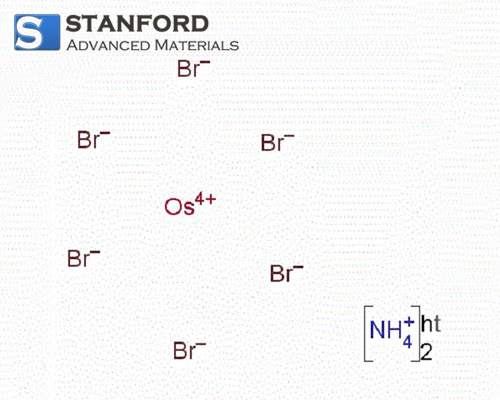
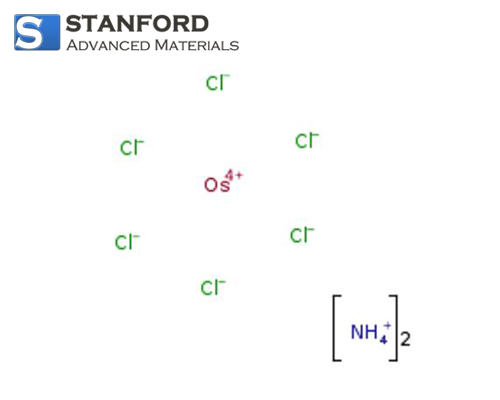
 Hydrate.jpg)
 Hydrate.jpg)
